Febin John James's Blog, page 9
February 1, 2018
How Will Blockchain Technology Empower Online Communities
 Photo by davide ragusa on Unsplash
Photo by davide ragusa on UnsplashIf you travel back in time to the early ages, you find tribes. Almost everyone belonged to a tribe. They worked for the common good. It’s still encoded in our genes. The only change being tribes are now called communities. You are part of different communities. You are an iPhone/Android fan, you may belong to a religious or an atheist community.
Wikipedia/Linux/Bitcoin/Ethereum were built by communities. Even profit organisations take community building seriously. Go to support forums of Apple/Google, your questions are answered by people like you and me. Communities are at the heart of every organisation. Communities played a major role in building the internet we have now.
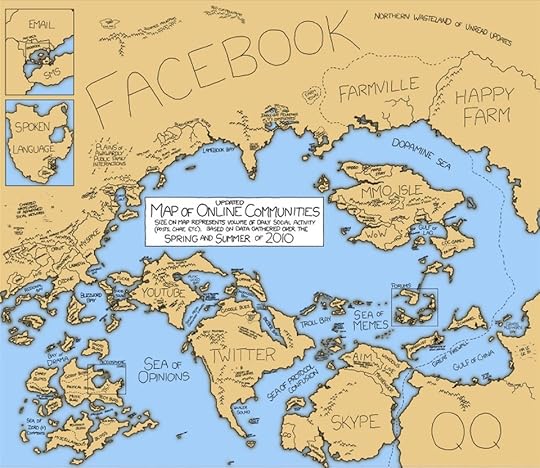 Credits : xkcd
Credits : xkcdIn order to motivate people and improve the quality of contributions communities incorporated gamification. Points, badges, titles, etc were given. Loyalty points, top writer on Medium, most viewed writer on Quora are some example. These, however, hold no monetary value. It may have a social value. That depends on people, a few might recognise it.
Open Source contributors are hardly compensated for their work. Some put a buy me a coffee page. If it’s a bigger organisation they give support to enterprises in order to make revenue .
Almost a year ago, I was part of Stanford crowd research. The mission of the community was to explain complex research papers in simple terms. In other words, making research accessible to all. There were a lot of perks for participating in the program. You get to network with similar minded people. You have direct access to people who work at Stanford. They will help you with a recommendation letter when you want to apply for college. Even a chance to co-author a research paper with them. We were part of a slack channel. When you make contributions community members rewarded you with points.
Some would have benefited from these perks. But, it wouldn’t benefit me much. I left college long back and I am not very keen on writing a research paper. What if I could trade my points with someone? Of course, they can’t co-author a paper or give a recommendation to someone they don’t know. However, a Skype session or few hours of consultation seems fair. Earn allows you to contact VCs, CEOs, Blockchain Influencers, Go/HTML/Javascript Programmers for $5–$100.
Communities can create their own tokens with Ethereum. For eg, the Kubernetes project by Linux Foundation can create a token called HLG. They can code a smart contract in the open Blockchain. That is if a developers pull request is accepted issue him 10 HLG tokens. Now the developer can use these tokens for a consultation with a senior Linux engineer. Or he can exchange the token in a token exchange for an SCR token from Stanford Crowd Research. In order to get an hour of consultancy from a Stanford lecturer. I hope you get the idea. People can even cash our their tokens. Earn is working on similar lines. This doesn’t have to be restricted to open source communities. Any online communities can incorporate tokens into their system. This will incentivise community contributors for their hard work.
Claps Please
January 31, 2018
You can tamper your version.
You can tamper your version. But remember the data is replicated across multiple computers? Blockchain will only consider what majority say is correct.

Popular Use Cases of Blockchain Technology You Need to Know
 Film-GrabApplications of Blockchain
Film-GrabApplications of BlockchainI am the Blockchain! I am invincible because I replicate myself on multiple computers. Yea like the Ultron. You cannot corrupt me. Though Bitcoin and Ethereum were my first applications. My true power is yet to be unleashed.
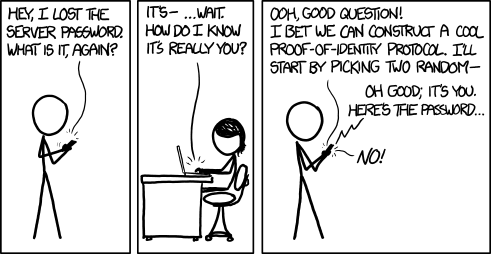 Credits : xkcdIdentity
Credits : xkcdIdentity
Let me start with identity cards, badges, and things. However, fancy may design it. It can be replicated. You know about 3D printers right? How do you verify them? Some organisations provide online verification service. You can scan the card or punch in the number and verify if it’s authentic. But, this can be costly, you need to pay for the cloud. With Blockchain you don’t have to build your own identity infrastructure, you can use Ethereum’s open Blockchain to store the identity details. Anyone who wants to verify just has to query the open Blockchain.
NotaryMost of your ownership records are stored in paper ledgers. These can be tampered. The data on Blockchain cannot be altered. On a Blockchain there are two things. A block and a chain. At a very high level, it is just a chain of blocks. Since it’s inside computers, we can rule out the physical stuff. Here digital information is divided into blocks and linked together. For example consider the following blocks, each represent a country. Each of them contains the city names of the respective country.
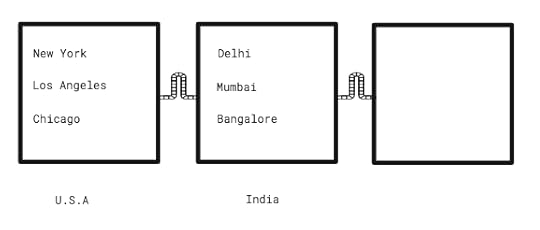
Wait, there is something more. Each of these blocks has something called a hash. A hash is a set of characters (eg. “1hi515AHA5H” ). Hash is derived from the information contained in the block. The block of U.S.A has cities New York, Los Angeles, and Chicago. So the hash would be something like “NYLAC” (Technically that’s not the case, but you get the idea).
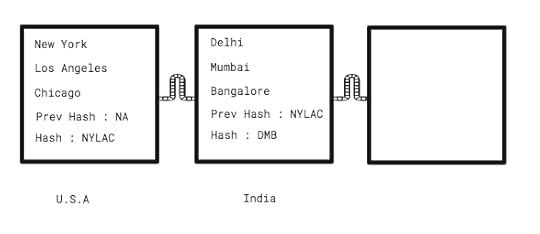
Every successive block will contain the previous block’s hash. This is what binds them together (The force). If someone tampers the first block to add the city Boston. The new hash becomes “NYLACB”. However, the succeeding block of India has already stored the hash as “NYLAC”. This mismatch will break the chain. So the purpose of hash is to make sure no one tampers it. The point I am trying to say is you can’t tamper my records. If you do, I will know.
Digital AssetsI hope you have heard about ICOs. It’s a new way to raise investment. Anyone anywhere can now become an investor. When someone invests in your company you should give them something back right? Like stocks or shares? ICOs offer a digital asset called token. These tokens will be stored on your Blockchain wallet. You will be able to use these tokens to pay for the company’s services or even exchange them at a later date when its value increases.
Smart Contracts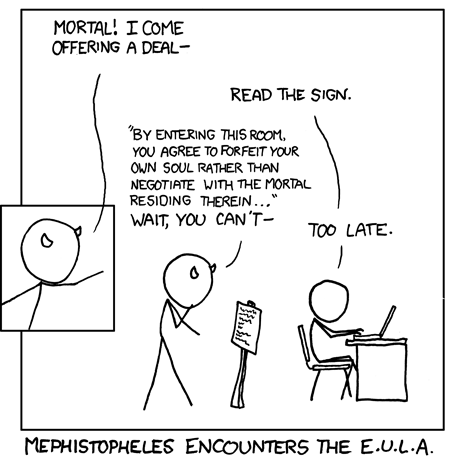 Credits : xkcd
Credits : xkcdMark and Sara
Mark hasn’t paid his rent for five months. When Sara questions he promise to pay later. She is helpless. She can’t afford a lawyer. Courts take eight months to almost a year to enforce action. The only option is to persuade Mark.
Joe’s business
Joe is a businessman. He does business with different corporates on a frequent basis. A few months ago he signed a contract with a retailer. Though the conditions of the contract were met. The retailer refused to pay. These people take advantage of the legal system and persuade Joe to settle for less pay. Joe had such experiences before. In some cases, he went to court. The time and money he spent there cost him his profits.
How do we help Sara and Joe?
Have we solved this problem elsewhere? In Sara’s case, we need to make Mark pay the rent every month. A time-based trigger. Your calendar app uses such trigger to give you notifications of predefined events.
In Joe’s case, once terms of the agreement is met the party needs to pay. It’s a condition based trigger. Consider the last time you purchased an ebook from Amazon. Amazon will only deliver it once the payment is confirmed.
The point is computer programs execute such instructions consistently. It did when you clicked on this article, scrolled down, etc . In order to help Sara, we need to convert the agreements of the contract into code.
Pseudo code of the smart contract between Sara and Mark
If today’s date is 30th and rent is not paid thenTransfer $500 from Mark’s account to Sara’s accountBut where do we deploy this code? It should be deployed on computers of all parties involved. Sara’s and Mark’s bank will be part of a private Blockchain network. Joe and Sara will sign a coded contract(a.k.a smart contract). Then it’s deployed on the network. Both Mark’s and Sara’s bank will have a copy. On 30th of every month when the clock ticks 12.00. The agreed amount gets transferred from Mark’s account to Sara’s account. Joe started using smart contracts to enforce his clients to pay the agreed amount.
Sara is happy because she doesn’t have to trust Mark’s consent to transfer rent. Joe’s glad because he doesn’t have to go to a court for justice. Instead, he can spend those efforts to grow his business.Digital Voting
Remember the last time you stood in a queue to vote? What if you can do it at home? The biggest problem with online voting is its security. Votes can be tampered or hackers can find out who you voted for. Blockchain can make your vote anonymous and provide better security. Since voter turnout in America is low, digital voting can bring in more participants.
Distributed StoragePresently you use services like Gdrive, Dropbox to store your files. The problem is you have to trust them that they won’t peep into your data. Governments can force them to disclose data if required. On Blockchain data is decentralised its stored on different computers on the network with high encryption. This can reduce costs. If you have excess storage on your computer, you can rent your excess storage capacity. Storj is an example. Yea, Airbnb or an Uber for digital storage. Claps Please
January 30, 2018
Hidden Opportunities for You on the Blockchain

Some part of me did regret for not investing in cryptocurrencies. But then I realised trading is not my thing. I want to do things where I have an advantage. I had invested in learning blockchain for the past few months. Now, I see opportunities that are no so obvious but rewarding. Since the field is emerging, only a few people understand blockchain to a deeper level. A majority understand it to the surface level. Some just heard about it and has no clue what it is. You can benefit a lot if you can gain deeper understanding of the technology. Blockchain For Business course on edX by the Linux Foundation is a good one. Blockchain Revolution is a recommended read. Once you have good understanding of the fundamentals you can teach others, bring in your own ideas or even launch them. Here are some opportunities you can benefit from.
Writing Stories Credits : xkcd
Credits : xkcdThere are a lot of articles with jargons about Blockchain, but stories are less. There is a good audience who is looking for simplified explanations. Since it’s an emerging market a lot of ideas are still to be imagined. You can write about Blockchain by thinking about its use cases in different industries. Eg. How will Blockchain impact the health industry? or the education industry? You can also write by combining ideas from different fields. Made to Stick is a great book that can help you explain topics simply in an understandable way.
WTF is The Blockchain?We already know blockchain’s killer appsTeaching with a Heart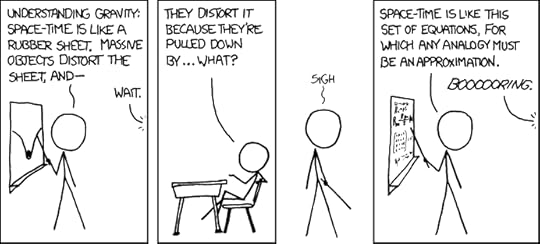 Credits : xkcd
Credits : xkcdI explored a lot of Blockchain courses in Udemy, Blockgeeks, etc. Some of these courses are good. But, there is a room for improvement. It can be made much simpler, interesting and engaging. I recently came across CryptoZombies. It teaches you to write a smart contract by building a game. It was on top of HackerNews. There is a good demand for such courses.
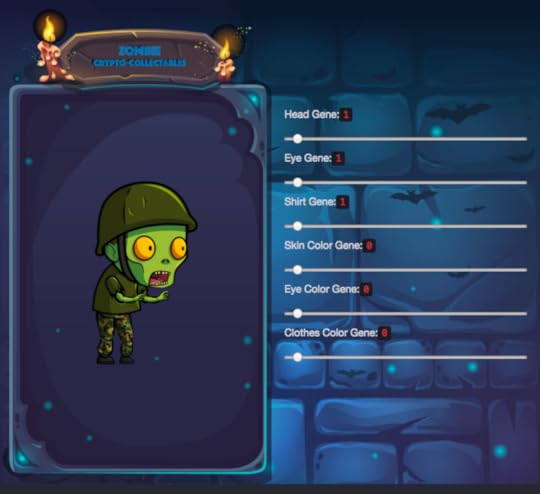 CryptoZombiesLearn Blockchains by Building OneHow does blockchain really work? I built an app to show you.Validating Ideas
CryptoZombiesLearn Blockchains by Building OneHow does blockchain really work? I built an app to show you.Validating Ideas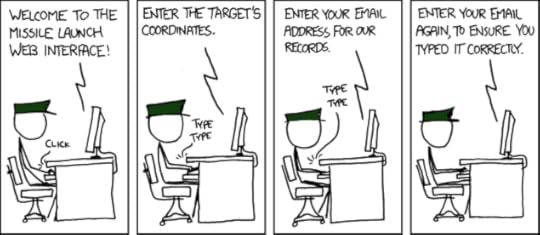 Credits : xkcd
Credits : xkcdYou have a startup idea. You know it works when you put it out on the market with a basic version of the product (MVP). Only when people pay you money you can be sure. Typically starting to accept payments can be difficult. You need to register a company, complete the legal process, etc. Cryptocurrencies help you prevent such hassles. You can create a wallet, set up the API and start accepting payments in no time.
https://medium.com/media/acf94831e13b3e065203f4f7498c6a69/hrefStarting up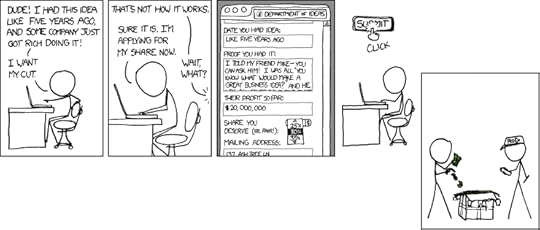 Credits : xkcd
Credits : xkcdIt’s difficult for non-techies to use blockchain themselves. Startups like Coinbase are addressing this market. There are potential in ideas which can help non-techies take advantage of Blockchain solutions like generating a smart contract, managing ICO funding, etc. I was exploring ICO turnkey solutions, most of them are expensive. You have to raise a seed round to afford such solutions. An affordable solution is definitely a need.
Creating Open Source Blockchain Projects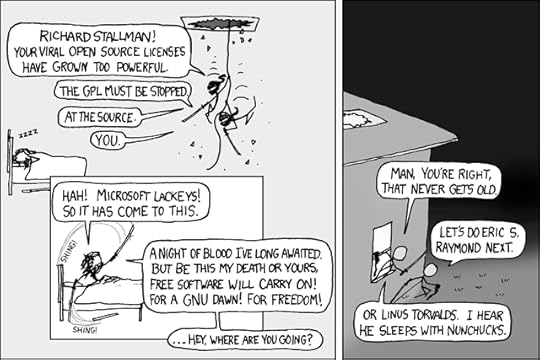 Credits : xkcd
Credits : xkcdIn the age of the internet, creating communities have become easy. When Vitalik Buterin’s ideas on Bitcoin was rejected, he started the Ethereum project with people who shared his ideas. If you don’t have ideas, I suggest going through the open source Blockchain based projects such as Bitcoin, Ethereum, etc. Think of ways it can be improved, or combine its ideas with a different domain. Ethereum ICO feature is a combination of decentralised payment system + crowdfunding.
Contributing to Open Source Blockchain Projects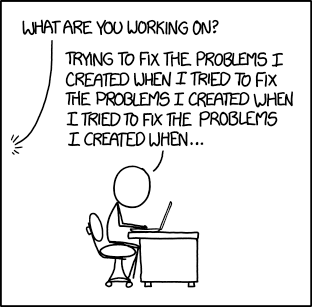 Credits : xkcd
Credits : xkcdA senior employee from the Linux Foundation addressed the problem that they need more contributors on their Hyperledger project. It’s rewarding to contribute to open source projects because it reflects your skill set. Employers value such open source contributions. If I want to hire someone, the first thing I do is to search for their Github profile and check for contributions.
Starting a Non-Profit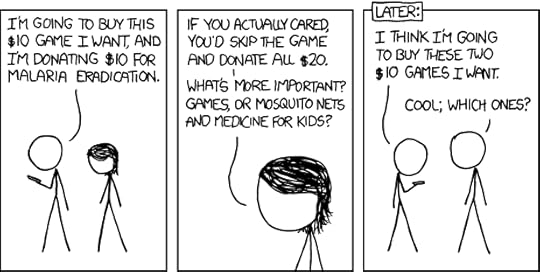 Credits : xkcd
Credits : xkcdThe biggest problem the Blockchain solves is that it eliminates the middleman. Producers get reasonable revenue for the work. In India middleman has exploited the agriculture industry. Non-Profits are trying to use the Blockchain to connect consumers and farmers directly on the Blockchain. Find an industry you are familiar which is exploited by a middleman. Experiment ways you can use Blockchain to eliminate them. There you go, you have an idea for a non-profit.
Ethereum is one of the biggest social enterprises on the Blockchain. They have created a platform which can benefit programmers, entrepreneurs, social entrepreneurs, miners, etc.
Investors can fund the Non-Profits with the help of a smart-contract. This means if only certain milestones are achieved the funding will be released. This will make Non-Profits more responsible for the work they do. Blockchain also increases transparency to the system. You can find out who exactly benefits from your donation on the Blockchain.
Raising Funds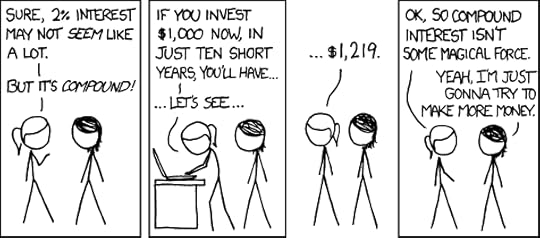 Credits : xkcd
Credits : xkcdIt has been never easier to raise investments for your idea. The biggest problem ICOs solved is anyone anywhere could be an investor. You don’t have to go through the tedious process or generate a certain amount of revenue to be eligible. Scamsters has taken advantage of these. In the future probably there would be some mechanism to prevent fraud. If you have an idea. investment wouldn’t be your biggest hurdle. You just need to convey the idea to the right people to help you raise investments. Entrepreneurs usually have these skills in their blood.
Emerging market brings in a lot of opportunities. So does the Blockchain market. Investing money is not the only thing that can be rewarding. Investing in reading, writing, programming, teaching and developing ideas on Blockchain can be more rewarding. If you can invest in these hidden opportunities when the massive adoption of Blockchain occurs, you will become thought leaders. Claps Please
January 25, 2018
How Can Blockchain Technology Innovate Your Education
It is simply tamper-proof logs that are publicly accessible. If you want to know more, please read my previous story A Beginner’s Guide to Blockchain.
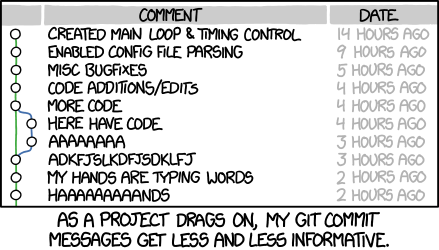 Credits : xkcdSponsoring Students
Credits : xkcdSponsoring Students
Olivia is a thirteen-year-old orphan. She is the brightest in her class. An NGO was supporting her all this while. Due to some internal politics the NGO decided to support Frank instead of Olivia.
How sad! The problem is humans can be biased, you can’t expect them to always act morally. Immoral acts cause corruption in the system. We don’t want corruption. We want our systems to be fair. This can be only achieved if decisions are made solely on logical reasons instead of human biases.
This is where computers come into the picture. Give them instructions. They will do exactly as commanded. They are not biased and don’t have emotions. Can we use this feature to our benefit?
John, Olivia’s School & the NGO can be part of a blockchain network (In other words their computers are interconnected with each other and they share the logs). Every transaction in the network is logged in the tamper-proof system. When John sponsors Olivia, he would be able to track the money he spent. He can be assured that his money was put to good use. He can even ask the computer to sponsor only if Olivia’s performances are good. This can motivate her to achieve good grades.
Skill Profile Credits : xkcd
Credits : xkcdOlivia has an EduBlock profile( It’s another tamper-proof log of one’s educational accomplishments ). She can pursue courses from different institutions, MOOCs, etc. Everything will be reflected in her public blockchain profile.
We have a lot of online MOOC’s that can help us with industry skills. Coursera, EdX, CodeSchool, CodeAcademy, etc. Instead of having individual profiles on these websites, Edublocks allows you to maintain a public profile on the Blockchain. You can learn from anywhere, your achievements will be reflected in your public profile. Employers can go through these profiles to send you job offers.
Skills In Demand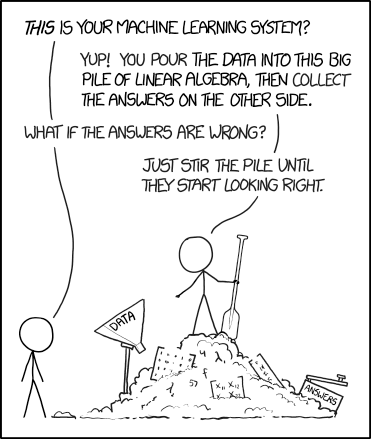 Credits : xkcd
Credits : xkcdWhen an employer hires through EduBlocks, it gets logged. Since these logs are public, we can track them to find which skills are in demand. We get real time insights. Presently we have to rely on data provided by companies like LinkedIn. These are not reliable since it could be tampered. Delayed data is inaccurate.
Olivia can benefit from reliable data, she knows in advance which course will guarantee her success.
Publishing Research Papers Credits : xkcd
Credits : xkcdOlivia submitted her research paper to a journal for publication. It has been six months, she has no clue about its progress.
Blockchain can enable Olivia to send her work to a small set of audience. Get their feedback real-time. These audiences can upvote or downvote their peers work. The more upvotes it gets, it will be pushed to a larger audience (Medium stories reaches a wider audience based on claps).
Olivia’s paper on cryptocurrency gained a lot of attention. She was offered an internship at Microsoft.
Educational Platforms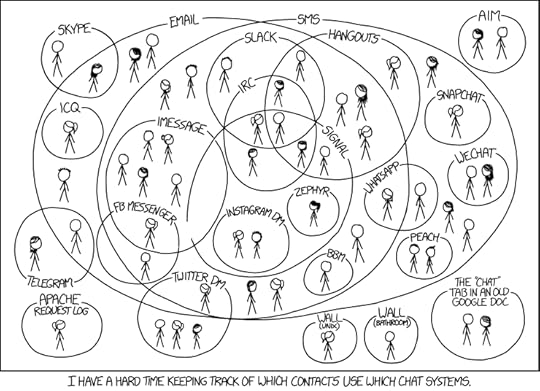 Credits : xkcd
Credits : xkcdLiveEdu is working on a Blockchain based learning platform. They connect different participants like content creators, learners, API developers, moderators, etc. You can register on their platform and learn from industry experts.
You can purchase EDU tokens from LiveEdu. These tokens can be used for various purposes like downloading course materials, requesting custom projects, getting replies from the content creator, etc. The more you learn, the more you earn. You earn EDU tokens for watching project videos, submitting project suggestions, inviting friends etc. You also get rewarded for being a community moderator. You get rewarded for quality assurance activities such as reporting bugs, content moderation, etc.
LiveEdu incentivises its content creators. They receive EDU coins for creating content. The more learners engage with the content the more its creator is rewarded.
We are still in the early stages of Blockchain disruptions. The best use cases are yet to be imagined. Claps Please
January 21, 2018
We are being fooled

We are being fooled/persuaded. I could be wrong. I couldn’t ignore some patterns I observed. Notice these titles, the first one is presently going viral( In India).
1. “Darwin’s theory wrong, nobody saw ape turning into man” — Some Minister
2. “We are here to change Constitution’” (Against secularism)— Another Minister
3. “Women wearing jeans not good for India: “ — Another Politician
These stories are engineered viruses. They are presently doing a great job on its hosts. When an educated person sees such ridiculous things. They tend to share and mock it. This cause the virus to spread further.
This is exactly the behaviour its creators intended. There could be a cunning agency behind this. Why would someone intentionally do that? Bad publicity right?
Unless the audience they target to reach are superstitious, believes India is a country exclusively for Hindus and thinks men and women are not equal.
In our widely populated country, is there such an audience? Is it a majority? Similar strategies were used by Donald Trump(Explained in the book Win Bigly by Scott Adams).
If so, we are being persuaded to get such leaders free votes. Instead of sharing such ridiculous content. May be we should educate others about science, living in harmony and gender equality.

January 11, 2018
Ravi Sinha I first publish on Facebook.
Ravi Sinha I first publish on Facebook. Here’s another one https://www.facebook.com/notes/febin-john-james/how-to-prevent-aadhar-misuse/1569905313056774/

Aadhar Security, Bringing Sticks to a Gun Fight
 Credits: Rishi Mohan
Credits: Rishi MohanWe have been told our data is completely secure and ‘hack-proof’. But, let me tell you, there is nothing in this world which is ‘hack-proof’.
During the Second World War, the Germans used Enigma machine to protect their messages.They could punch in a message (eg.“Food supplies coming from the west”). The machine would produce gibberish, (eg.”A1B2# C3D4$#ED JD@#KK #$%%#”). This is broadcasted over the radio. On the receiving end, when you type the same gibberish, you get back the original message. It was only a matter of time. Alan Turning cracked the Enigma code which played a key role in the defeat of the Nazis.
The inventor of the Enigma machine made some mathematical assumptions. Alan Turing broke those assumptions which enabled him to crack the code. Security is built around such technical assumptions. We have a lot of Alan Turings(hackers) who challenge those assumptions and break them. Such incidents occurred numerous times during in the past. It will continue to happen, that is how we advance. Considering past events how can one call their system ‘hack-proof’?
When you visit Aadhar’s portal, you see buttons, images, information etc. But, a security expert sees things which are invisible to naked eyes. They have seen security flaws and pointed it out several times. They gave solid proof that UIDAI’s security is weak. Their intention is only to strengthen Aadhar security.
When your child does something wrong, you correct them for their own benefit. Sometimes he/she accepts and rectifies their mistake. Sometimes they don’t accept their mistake and cry “ I don’t like you ”.
We have such a child here, who fail to accept the security flaws and label those who try to help as “Campaigners against Aadhar”.
Bringing Sticks to a Gun FightHave a look at the mAadhaar app.
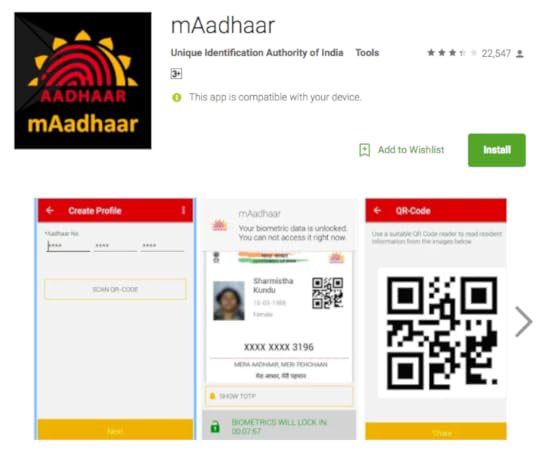
It stores your profile information (Name, Date of Birth, etc). It allows certain functionality such as biometric locking/unlocking and time-based OTP generation.
When you open the app for the first time, it asks you to set a password. Later, you can use the same password to unlock its functionalities. Hence, even if someone steals your phone, they can’t access the app.
A French security researcher downloaded the app. He found something strange.
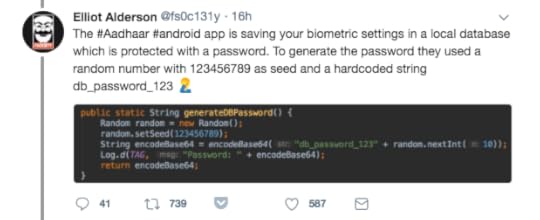
The password you set while registering is stored in a safe box. Every time, you open the app, it asks you to enter your password, the app then unlocks the safe box and check if they match. If it does, you get access to the app.
There exists a key to the safe box where your password is stored. The key is simply a set of characters like “A233ASD”. If this key is compromised then anyone can access your password and access the app’s functionalities.
The key to the safe box must be unique. Your key and my key shouldn’t be the same. If it is same, I can unlock your phone’s safe box with my key and get access to its functionalities. The French security researcher found out that all mAadhar customers have the same key.
It’s like the Indian government giving its citizens a lock and key to secure their houses. The problem is every citizen has the same exact lock. Anyone can open anyone else’s house with their own key.
I have seen such stupidity in Suppandi stories. Your mAadhar app is presently vulnerable. One can choose to believe it or delude oneself to authorities who say “Your data is completely secure and ‘hack-proof’”.
 Original Tweet
Original Tweet
Aadhar Security, Bringing Sticks to a Gun Fight was originally published in Hacker Noon on Medium, where people are continuing the conversation by highlighting and responding to this story.
January 10, 2018
UIDAI provides you with an API not an application.
UIDAI provides you with an API not an application. Application can be developed by anyone who has license from UIDAI. You can program your application to record the fingerprint, send it to UIDAI for verification and you also have the option to store it or not to keep it. In an ideal world you are supposed to follow the rules. But, in the real world people still chose to break rules and we have criminals. The layman(customer executive) here was used as an example to make people understand. Any third party service like the airtel has ability to store the finger print and replay it. I agree, there are rules. But, they can break it.
Bharti Airtel used the Aadhaar-eKYC based SIM verification process to open payments bank accounts of its subscribers without their ‘informed consent’.
UIDAI Bars Airtel, Airtel Payments Bank from Conducting Aadhaar-based SIM Verification
In this case they were banned but that need not happen every time. This was because they did it to a massive number of people.
Third party services can break the rules and argue that the customer themselves did it.

The fingerprint scanner scans your finger and converts it to digital data.
The fingerprint scanner scans your finger and converts it to digital data. Once it has become digital, you can store it.




